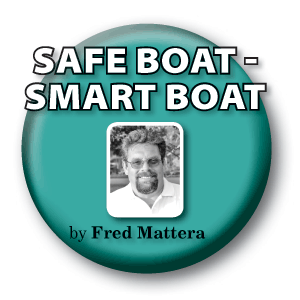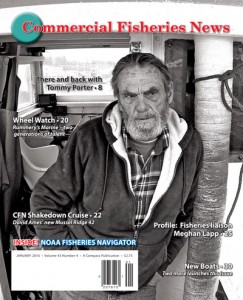I was prompted to review the use of flares this month after recently reading an article of a 60’ sightseeing vessel with 27 people onboard that capsized so quickly that no distress call was made.
Fortunately, the life raft deployed – providing shelter for some of the individuals – and unbeknownst to them they found a flare kit in the life raft survival pack. They took the initiative and activated a parachute flare, which was sighted by two nearby fishermen motivating them and other fishermen to provide assistance.

A qualified Coast Guard-approved marine drill instructor, Fred Mattera of Point Judith, RI is the owner/president of North East Safety Training Co. (NESTCo), which conducts fishing vessel drills and inspections and basic safety training workshops.
Outcome was that 21 individuals were rescued and 6 loss their lives. This incident could have had a much more tragic conclusion without the use of a flare.
Thus, my concern: Do you know where your flares are on your boat, are the compliment of flares based on the location of your fishing, do you know how to activate them, know they are not expired, and that they are readily accessible?
Also, recognize that you have a full compliment of flares in your life raft survival pack.
Number of flares required
I am often asked what to do with old, expired flares or if I want them. Actually, I do take and use them to conduct hands-on flare training. I also tell captains to consider keeping an expired flare kit in a container marked “for training purpose only,” distinguishing them from the vessel’s updated kit, and use them for at-sea training.
Flare kits are required safety equipment on commercial fishing vessels. Outside of 50 miles, a vessel needs a SOLAS A kit containing six hand-held, three orange floating smoke, and three parachute flares.
From three miles to 50 miles, vessels are required to have a SOLAS B kit with the same number of flares and types. These are just a little less bright and burn for a shorter duration.
SOLAS stands for the International Convention for the “Safety of Life at Sea,” a maritime safety treaty. To distinguish the two kits, SOLAS A kits are marked as 160.121 and SOLAS B as 160.021. Note the difference in the last three digits, which, for SOLAS A, starts with the numeral 1 and, for SOLAS B, starts with the numeral 0.
Cost is a factor as well. SOLAS A kits are more expensive. But there are times when I see SOLAS B flares on an offshore vessel, which means the boat is not in compliance.
Flares also are included in the equipment package aboard your life raft, identical in number and type as the flare kit you need for your vessel.
Read the instructions
Flares are excellent distress signaling devices but all have their advantages and disadvantages. They can be used only once, and they can cause injury or property damage if not properly handled. It is extremely important to read the instructions.
Always look for the direction of the arrow on the flare, which points to the end of the flare that ignites. I have witnessed a parachute flare shot right into the toe of a fisherman’s sneaker.
The flare itself is very hot and will expel ash and slag as it burns. Even though these particles cool quickly, they can cause a painful burn or ignite materials. Always take the wind into consideration and keep it at your back. Also, you must hold a hand-held flare over the side and in such a way that neither you nor the raft is damaged.
Pistol-launched and hand-held parachute flares have many of the same characteristics of a firearm and must be handled with the same caution and respect. Never aim flares directly at a searching aircraft or surface vessel.
Hand-held or floating orange smoke flares work best on clear days with light winds. They tend to lose effectiveness in high winds because the smoke rapidly disperses. So, they are best used during a helicopter rescue, providing a large target and indicating wind direction to the helo crew once it’s in sight.
Red hand-held flares can be used during the day but are most effective at night or in restrictive visibility such as fog or haze. Always hold only the plastic handle at arm’s length before igniting. Turn your head away and, again, be sure the wind is at your back.
Pistol-launched flares can be used during the day but are most effective at night. Because they descend rapidly, their burning time is shorter and they may not be as readily seen as a slow-descending flare.
Red parachute flares are good for both day and night because of their altitude, slow descent, and brilliant intensity.
From the raft
Once you are situated in the life raft, one of the first things you should do is to ignite a parachute flare to alert vessels within a 20-mile radius that may not have heard a Mayday call to your position.
This parachute flare is shot out of a tube and ascends to 1,000’ in approximately two seconds. It then slowly descends over 25-30 seconds giving off a bright red light.
This is a very powerful and dangerous flare. Again, read the directions. Find the arrow and point it toward the sky at an 80°–85° angle. Hold it with your knuckles facing toward your body at chest-to-chin height before activating the trigger.
I have seen a fisherman ignite a parachute flare and shoot it right by his ear and down the side of a building because he was holding the flare with his knuckles not facing him. I can’t emphasize the importance of properly handling this type of flare.
Storage
Store your flare kit in a brightly colored container in a cool, dry, and readily accessible place. Everyone onboard should know where the flares are.
Also, assign one crewman responsibility for grabbing the flare kit as part of your abandon-ship procedure. You may want to store a pair of welding gloves and protective eye wear in the container.
Expiration dates are important as these flares are only good for three years from the time of purchase. Expired flares do not count as part of your minimum requirements. If you don’t want to save expired flares, again storing them in a clearly marked container for training purposes, dispose of expired flares by bringing them to your local fire or police department. Do not place them in the trash.
“Wow, I never realized how bright and hot the hand-held flares are, not to mention how scary and powerful and quick a parachute flare is. I’m glad I’m activating them here in a drill rather than at sea in peril.”
I’ve heard comments like this hundreds of times.
Take time to train. Don’t end up the victim. An excellent opportunity to activate and ignite flares is during the series of free safety and survival training sessions that will be offered by the Fishermen’s Partnership Safety Training Program. For more info, call the partnership at (617) 928-3443.
 To get the rest of this story and the January issue of Commercial Fisheries News –
To get the rest of this story and the January issue of Commercial Fisheries News –
please choose from the following options:
BUY a Single PRINT edition of CFN that is delivered by MAIL.
Click Here for PRINT EDITION
Quickly enjoy ONLINE access with our feature packed flip-book.
PURCHASE ONLINE EDITION
(Read online flip-book immediately with access key and download a copy for yourself. Not sure? SAMPLE HERE)
SAVE BIG when you SUBSCRIBE!







